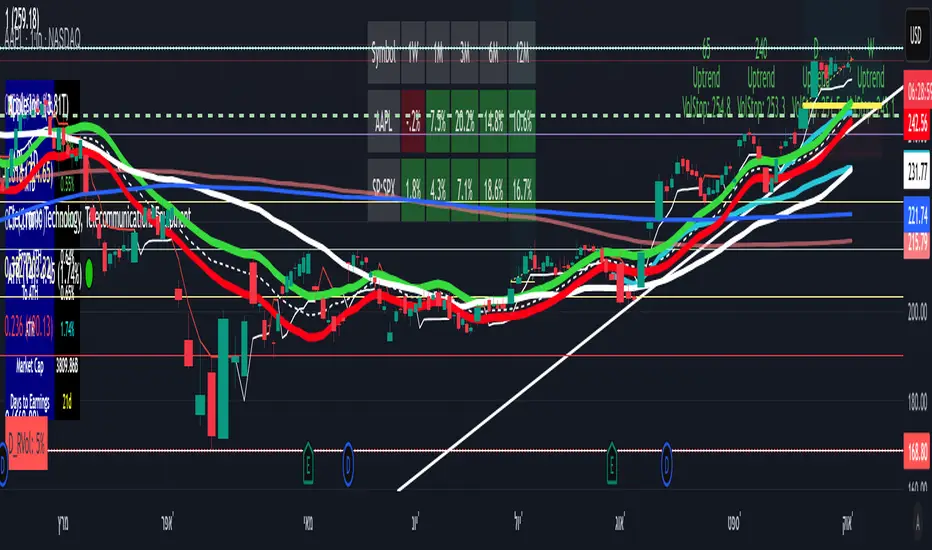OPEN-SOURCE SCRIPT
已更新 Multi-Timeframe Trend Status

This Multi-Timeframe Trend Status indicator tracks market trends across four timeframes ( by default, 65-minute, 240-minute, daily, and monthly). It uses a Volatility Stop based on the Average True Range (ATR) to determine the trend direction. The ATR is multiplied by a user-adjustable multiplier to create a dynamic buffer zone that filters out market noise.
The indicator tracks the volatility stop and trend direction for each timeframe. In an uptrend, the stop trails below the price, adjusting upward, and signals a downtrend if the price falls below it. In a downtrend, the stop trails above the price, moving down with the market, and signals an uptrend if the price rises above it.
Two input parameters allow for customization:
ATR Length: Defines the period for ATR calculation.
ATR Multiplier: Adjusts the sensitivity of trend changes.
This setup lets traders align short-term decisions with long-term market context and spot potential trading opportunities or reversals.
The indicator tracks the volatility stop and trend direction for each timeframe. In an uptrend, the stop trails below the price, adjusting upward, and signals a downtrend if the price falls below it. In a downtrend, the stop trails above the price, moving down with the market, and signals an uptrend if the price rises above it.
Two input parameters allow for customization:
ATR Length: Defines the period for ATR calculation.
ATR Multiplier: Adjusts the sensitivity of trend changes.
This setup lets traders align short-term decisions with long-term market context and spot potential trading opportunities or reversals.
發行說明
Fixed a bug; the indicator results should not be affected by the graph's time frame. More option for user preferences.發行說明
In this version some bugs are fixed.Multi-Timeframe Trend Status indicator that tracks market trends across four timeframes ( by default, 65-minute, 240-minute, daily, and monthly). It uses a Volatility Stop based on the Average True Range (ATR) to determine the trend direction. The ATR is multiplied by a user-adjustable multiplier to create a dynamic buffer zone that filters out market noise.
The indicator tracks the volatility stop and trend direction for each timeframe. In an uptrend, the stop trails below the price, adjusting upward, and signals a downtrend if the price falls below it. In a downtrend, the stop trails above the price, moving down with the market, and signals an uptrend if the price rises above it. The indicator output is presented in a table that indicates for each timeframe whether the trend direction.
發行說明
Multi-Timeframe Trend Status Indicator This custom indicator tracks trend direction and Volatility Stop levels across four user-defined timeframes (e.g., 65min, 4h, Daily, Weekly). It uses a smoothed ATR-based logic to detect trend shifts and displays the results in a color-coded table directly on your chart.
🔧 Features:
Trend detection using Volatility Stop logic
Alerts on trend changes per timeframe
Customizable table position and font size
Visual markers for trend shifts
✅ Bug Fix:
The previous issue with dynamic alert messages has been resolved. Alerts now use static strings, ensuring full compatibility with TradingView’s alertcondition() requirements.
開源腳本
秉持TradingView一貫精神,這個腳本的創作者將其設為開源,以便交易者檢視並驗證其功能。向作者致敬!您可以免費使用此腳本,但請注意,重新發佈代碼需遵守我們的社群規範。
免責聲明
這些資訊和出版物並非旨在提供,也不構成TradingView提供或認可的任何形式的財務、投資、交易或其他類型的建議或推薦。請閱讀使用條款以了解更多資訊。
開源腳本
秉持TradingView一貫精神,這個腳本的創作者將其設為開源,以便交易者檢視並驗證其功能。向作者致敬!您可以免費使用此腳本,但請注意,重新發佈代碼需遵守我們的社群規範。
免責聲明
這些資訊和出版物並非旨在提供,也不構成TradingView提供或認可的任何形式的財務、投資、交易或其他類型的建議或推薦。請閱讀使用條款以了解更多資訊。